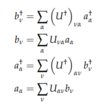Chapter 5: Second Quantization Flashcards
(36 cards)
Second Quantization
(Overview)
- Misleading, not quantizing anything, but rather changing representations
-
Consider: Many-Body Problem in First Quantization
- Hilbert Space
- Basis
- Correct symmetry for particle type

Fock States and Spaces

Second Quantization
(Take-Away)
- s,a account for permutations → ordering irrelevant
- Number of modes in {αi} now important ← new “occupation” representation
- Need to consider what happens with addition/subtraction of mode for both bosons and fermions
Second Quantization
(Bosons: Overview)
- Vacuum state ≡ | 0 >
- Creation/annihilation operators a† , a
- Commutation relations guarantee wavefunction remains symmetric

Second Quantizaion
(Bosons: Action of a,a†)

Second Quantization
(Bosons: General State)
State α occupied by N particles

Second Quantization
(Bosons: Notes)
- | { nα } > form complete basis set for symmetric Fock space
- Order unimportant for bosons
- Creation/annihilation operators act only on specific state
- Total number operator Ntot

Second Quantization
(Bosons: Connection to Wavefunction)

Second Quantization
(Fermions: Overview)
NOTE: Similar to bosons with + → − and a few exceptions
- Commutator not well defined
- Operators anti-commute

Second Quantization
(Fermions: Actions of c, c†)

Second Quantization
(Fermions: General State)

Second Quantization
(Fermions: Notes)
Ordering is important

Second Quantization
(Single-Particle Operator)
Let Ai be single-particle operator

Second Quantization
(Two-Particle Operator)
Let Aij be a two-particle operator

Second Quantization
(Basis Transformation)
- Let φα(x), χν(x) be complete, orthonormal basis sets with (creation) annihilation operators aα(†) , bν(†)
- NOTE: Commutation relation still holds

Field Operator
(Overview)
- Recall: single-particle wavefunction φαs(r) in mode α with spin s
- Field operator creates/destroy particle at r

Field Operator
(Commutation Relations)
(Anti-)Commutators follow as that for (fermions) bosons
- Bosons
- Fermions

Field Operator
(General State)

Field Operator
(Take-Away)
- Can always swtich between these two:
- wavefunction picture ⇐⇒ first quantization
- state picture ⇐⇒ second quantization
Field Operator
(Single-Particle Operator)
Let A1 be single-particle operator

Field Operator
(Two-Particle Operator)
Let A2 be two particle operator
- NOTE: ψ†(r1)ψ†(r2)ψ(r2)ψ(r1) ordering removes self-interaction

Field Operator
(Hamiltonian)

Correlations in Non-Interacting Fermi Gas
(Green’s Function)
NOTE: j1 is Bessel function

Correlations in Non-Interacting Fermi Gas
(Green’s Function: Graph)












